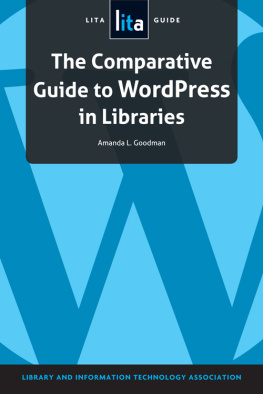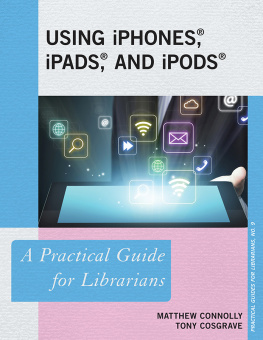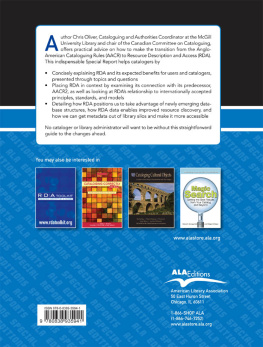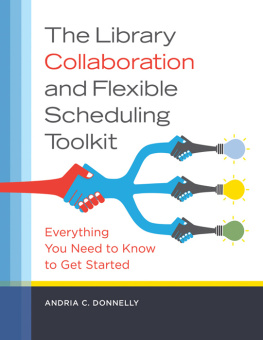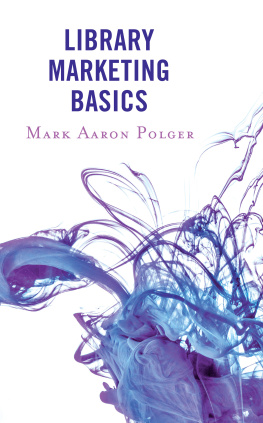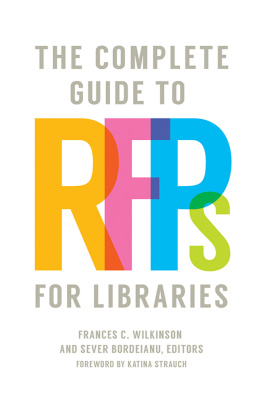David Beasley - Beasleys Guide to Library Research
Here you can read online David Beasley - Beasleys Guide to Library Research full text of the book (entire story) in english for free. Download pdf and epub, get meaning, cover and reviews about this ebook. year: 2016, publisher: University of Toronto Press, genre: Romance novel. Description of the work, (preface) as well as reviews are available. Best literature library LitArk.com created for fans of good reading and offers a wide selection of genres:
Romance novel
Science fiction
Adventure
Detective
Science
History
Home and family
Prose
Art
Politics
Computer
Non-fiction
Religion
Business
Children
Humor
Choose a favorite category and find really read worthwhile books. Enjoy immersion in the world of imagination, feel the emotions of the characters or learn something new for yourself, make an fascinating discovery.

- Book:Beasleys Guide to Library Research
- Author:
- Publisher:University of Toronto Press
- Genre:
- Year:2016
- Rating:3 / 5
- Favourites:Add to favourites
- Your mark:
- 60
- 1
- 2
- 3
- 4
- 5
Beasleys Guide to Library Research: summary, description and annotation
We offer to read an annotation, description, summary or preface (depends on what the author of the book "Beasleys Guide to Library Research" wrote himself). If you haven't found the necessary information about the book — write in the comments, we will try to find it.
Written and organized for easy access, the reader is guided step-by-step through library rules and methods of operation, the effective use of various cataloguing systems, and the location of materials.
Beasleys Guide to Library Research — read online for free the complete book (whole text) full work
Below is the text of the book, divided by pages. System saving the place of the last page read, allows you to conveniently read the book "Beasleys Guide to Library Research" online for free, without having to search again every time where you left off. Put a bookmark, and you can go to the page where you finished reading at any time.
Font size:
Interval:
Bookmark:
BEASLEYS GUIDE TO LIBRARY RESEARCH
Beasleys Guide to Library Research offers straightforward help in navigating the labyrinth of library research. Suitable for novices and experienced researchers alike, this revised classic is an invaluable tool for locating and using materials from research libraries anywhere in the world.
Written and organized for easy access, the book guides the reader step by step through library rules and methods of operation, the effective use of microfilms and various cataloguing systems, and the location of materials using bibliographies, reference books, and periodical indexes. Also covered are the most modern forms of research, including computer databases, interlibrary loan systems, and online computer searches.
Whether the reader is a student, teacher, writer, librarian, or businessperson, Beasleys Guide to Library Research provides the essential information that enables all library users to make the most of their research time.
David Beasley was a reference librarian for 28 years at the New York Research Libraries.
Other Books by David Beasley
The Canadian Don Quixote: The Life and Works of Major John Richardson, Canadas First Novelist (Erin, ON: Porcupines Quill, 1977)
Through Paphlagonia with a Donkey: A Journey through the Turkish Isfendyars (New York: Davus, 1983)
Introduction, Major Richardsons Short Stories (Penticton, BC: Theytus, 1986) (editor)
The Suppression of the Automobile (Westport, CT: Greenwood, 1988)
How to Use a Research Library (New York: Oxford University Press, 1988)
That Other God (Simcoe, ON: Davus, 1993) (novel)
The Jenny: A New York Library Detective Novel (Simcoe, ON: Davus, 1994)
Hamilton Romance: A HamiltonToronto Nexus (Simcoe, ON: Davus, 1996)
Chocolate for the Poor: A Story of Rape in 1805 (Simcoe, ON: Davus, 1996)
Who Really Invented the Automobile? (Simcoe, ON: Davus, 1997)
The Grand Conspiracy: A New York Library Mystery (Simcoe, ON: Davus, 1997)
Douglas MacAgy and the Foundations of Modern Art Curatorship (Simcoe, ON: Davus, 1998)
Pagan Summer (Simcoe, ON: Davus, 1998)
Understanding Modern Art: The Boundless Spirit of Clay Edgar Spohn (Simcoe, ON: Davus, 1999)
Aspects of Love: Helen, Caravetti, Adam (Simcoe, ON: Davus, 2000)
DAVID BEASLEY

David R. Beasley 2000
Toronto Buffalo London
Printed in Canada
ISBN 0-8020-4782-3 (cloth)
ISBN 0-8020-8328-5 (paper)

Printed on acid-free paper
An earlier form of some of the material in this book appeared in How to Use a Research Library (New York: Oxford University Press, 1988).
Canadian Cataloguing in Publication Data
Beasley, David, 1931
Beasleys guide to library research
Rev. ed. of: How to use a research library.
Includes bibliographical references and index.
ISBN 0-8020-4782-3 (bound) ISBN 0-8020-8328-5 (pbk.)
1. Library research Handbooks, manuals, etc. 2. Research libraries
Handbooks, manuals, etc. 3. Research Methodology Handbooks, manuals, etc. I. Title. II. Title: Guide to library research. III. Title: How to use a research library.
Z675.R45B42 2000 025.524 C00-931640-X
University of Toronto Press acknowledges the financial assistance to its publishing program of the Canada Council for the Arts and the Ontario Arts Council.
University of Toronto Press acknowledges the financial support for its publishing activities of the Government of Canada through the Book Publishing Industry Development Program (BPIDP).
In memory of Aloysius and Marie Nicholas
This short book is intended for the college student, the casual researcher, and the professional researcher and writer. Those unfamiliar with libraries should read this text from the beginning; more experienced readers can go directly to particular sections outlined in the table of contents.
In this revised edition of How to Use a Research Library (Oxford University Press, 1988) I have included material on the use of electronic bibliographic aids to find information and locate articles and books, added information on microform resources, and updated bibliographic references.
Procedures are basically the same for all research libraries; they differ in minor ways such as the form of request slip or kind of catalogue. At the end of the book I note some of the differences I have encountered in major research libraries.
There are many levels of research and many different kinds of facts you will need to know. This work will have served its purpose admirably if it helps you apply the most efficient methods of library research to find the bibliographic tools most useful to your own particular needs.
DRB
Simcoe, Ontario
September 1999
BEASLEYS GUIDE TO LIBRARY RESEARCH
This section is a brief overview for those who want to locate a publication in the library right away or need a quick review of the essentials. begins a detailed initiation into the use of research libraries. Specific examples and references throughout this book are to the major research libraries, but the general procedures are similar in all research libraries. The following are some points to keep in mind about using a reference section:
1. Books and periodicals in research libraries can only be consulted. You cannot borrow them.
2. There are several catalogues and many ways of finding publications; some you can find only by asking the librarian (for further details, see p. 43).
3. To make a photocopy from a publication, you must obtain a pass from the librarian to take it from the reading room to the photoservice section.
4. If the library does not have the publication available through the catalogues whether in book or online form, or in deferred status or microform the librarian can obtain it for you from another library, or in some cases give you a pass to see it in a library within the metropolitan area (see ).
5. When you have located the publication in the catalogue, do not forget to write down the call number on the request slip.
6. To use the Special Collections for rare or manuscript materials (e.g., Print Collection, Rare Book Room, Manuscripts and Archives), you will have to show proof that you are a researcher and may need to obtain a pass from the Office of Special Collections.
When you enter a research library, ask the librarian at the information desk near the main entrance to guide you to the division where the publications you want are located. If you want a reference work, such as an almanac, directory, or encyclopedia, the librarians at the reference desks can tell you where you can take it off the open shelves in the reading rooms. This saves you from using the library catalogues.
In large research libraries, book stacks are closed to the reader. You must file your request slip for a publication at a specified desk and wait for a library page or assistant to retrieve the publication from the stacks. In university libraries, the book stacks are usually open to readers. You are expected to find the stack level on which the publication is stored and retrieve it for use in the reading rooms. University libraries, unlike public research libraries, allow readers registered with them to borrow publications.
Next pageFont size:
Interval:
Bookmark:
Similar books «Beasleys Guide to Library Research»
Look at similar books to Beasleys Guide to Library Research. We have selected literature similar in name and meaning in the hope of providing readers with more options to find new, interesting, not yet read works.
Discussion, reviews of the book Beasleys Guide to Library Research and just readers' own opinions. Leave your comments, write what you think about the work, its meaning or the main characters. Specify what exactly you liked and what you didn't like, and why you think so.

